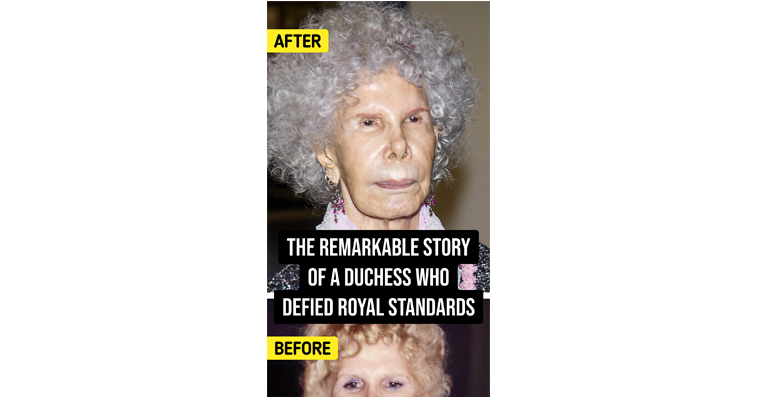Cayetana Fitz-James Stuart, the 18th Duchess of Alba, was a woman who transcended the conventional expectations of aristocracy. With an astonishing 57 noble titles, Cayetana made history as the most titled aristocrat in the world. Not just a woman of wealth, with an estimated fortune of 3 billion euros, she was also a prominent figure in Spain’s aristocratic circles. Her life was marked by opulent weddings, controversial marriages, and a constant reinvention of herself. Through it all, Cayetana embodied the spirit of independence and rebellion, creating a legacy that will never be forgotten.
Cayetana was not your typical aristocrat. Rather than adhering to the conservative values of her noble background, she chose to live life on her own terms. Known for her free-spirited nature, Cayetana often defied the norms of high society with her flamboyant wardrobe, bold personality, and unconventional relationships. Her untamed curls and chic outfits became her signature, setting her apart from the more traditional members of the aristocracy.
Video:
Cayetana Fitz-James Stuart, 18th Duchess of Alba
One of the most famous incidents from her life was her refusal to be painted by the iconic artist Pablo Picasso. Her response? “I have more noble titles than the Queen of England!” This statement summed up her independent spirit, and it’s clear that she relished being a symbol of rebellion in a world that prized tradition.
Cayetana’s aristocratic heritage was deeply entwined with European history. She was directly linked to renowned figures like Sir Winston Churchill and Princess Diana through her ancestry, which traced back to Henrietta Fitz-James, daughter of Arabella Churchill. This royal lineage gave Cayetana a unique position in both British and Spanish aristocracy, and her family’s status was a key part of her identity.

However, despite her privileged upbringing, Cayetana’s memoirs revealed the challenges she faced. She showed that life as a noblewoman, while filled with luxury, also came with emotional and personal struggles that were often overlooked by the public.
Cayetana’s marriage to Luis Martínez de Irujo y Artázcoz in 1947 was one of the most extravagant events in Spanish history. Their wedding, considered Spain’s last grand feudal celebration, was attended by 2,500 guests and cost an estimated 20 million pesetas. This moment marked the beginning of Cayetana’s transformation into a public figure with a unique role in Spain’s aristocracy.

Following the death of her father in 1953, Cayetana inherited a vast number of titles, including 18 counts, 14 grandees, and five duchies. Along with these titles came the enormous responsibility of managing the family’s estates, including the historical Liria Palace. This palace, though damaged during political upheavals, was a symbol of her deep commitment to her heritage and her family’s legacy.

Cayetana’s romantic life was as dramatic as the grand narratives of aristocracy. Her second marriage, in 1978, to Jesús Aguirre y Ortiz de Zárate, a former priest and her former confessor, created a scandal within high society. Not only was Aguirre much younger, but the couple’s unconventional union caused waves due to his illegitimate birth. However, their marriage lasted until his death in 2001, proving the strength of their bond despite the scrutiny.

Her third marriage, to Alfonso Díez in 2011, was even more controversial. Díez, a civil servant more than 20 years younger than Cayetana, was accused by some of being a fortune hunter. Despite the controversy, Cayetana’s decision to marry him reflected her refusal to be constrained by societal norms. Their wedding became iconic, marked by Cayetana’s spirited flamenco dance, showing that she was still living life on her own terms.

Cayetana’s public image evolved over time, especially in relation to her appearance. She underwent several cosmetic procedures, sparking media attention and speculation. Despite this, Cayetana remained unapologetic about her choices. She once quipped that her cosmetic surgeries were done because she couldn’t exactly “eat her artwork,” showing her wit and self-confidence.

Her transformation, both physically and emotionally, made her a figure of fascination for the media. But for Cayetana, the focus was always on living authentically, regardless of public opinion. She continued to embrace change and reinvention, fully understanding that life was about the journey rather than the destination.

Cayetana’s passing marked the end of an era in Spain’s aristocracy, but her influence remains as powerful as ever. She embodied the spirit of aristocracy while rejecting its most stifling conventions. Her legacy lives on through her noble titles, her wealth, and the indelible mark she left on Spanish and European history.
Video:
A stunning collection by the world’s most titled woman, Duchess Caetana de Alba
Cayetana’s life was a bold statement of independence, strength, and resilience. Through her marriages, her aristocratic heritage, and her personal evolution, she demonstrated that true nobility is found in one’s ability to remain true to oneself.

Cayetana Fitz-James Stuart’s journey was not one defined by rigid norms but by a relentless pursuit of freedom, individuality, and self-expression. A woman who had everything but chose to live life on her own terms, she will forever be remembered as a true icon of aristocracy and a symbol of rebellion. Her legacy is one of unwavering strength, inspiring future generations to live boldly and fearlessly.


